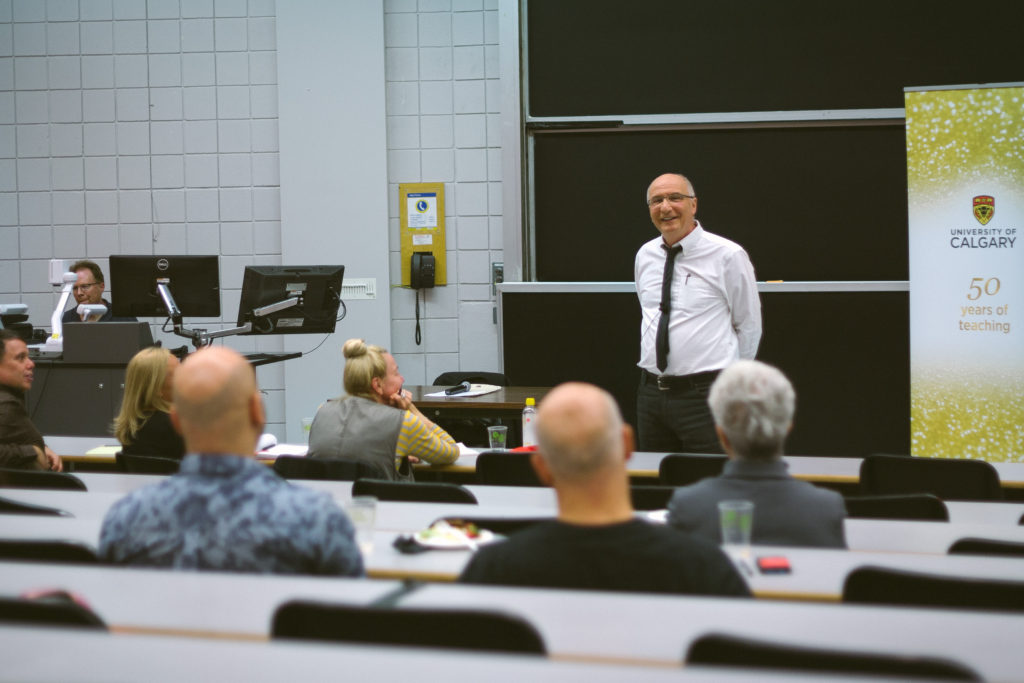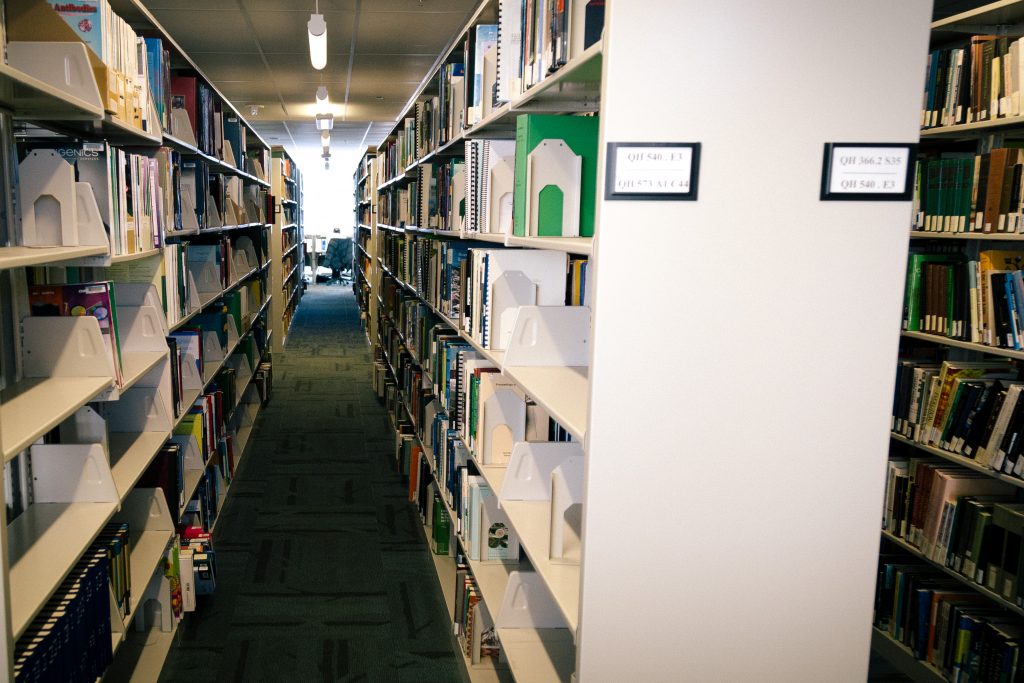
The rising price of knowledge: University of Calgary cuts 1,600 academic resources
By Scott Strasser, January 16 2017 —
In the world of academia, knowledge is a commodity with rising costs — that much is evident within the University of Calgary’s libraries collections.

U of C geography professor Byron Miller spoke out about the cancellations // Photo by Justin Quaintance
This year, the U of C’s libraries and cultural resources department has cancelled academic journal subscriptions valued at $1.5 million. The cancellations include roughly 1,600 academic resources, including 887 journals from prominent Taylor & Francis bundles.
The reveal of the cancelled subscriptions — several hundred of which went into effect on Jan. 1 — sparked anger from some U of C faculty members.
“These are not just minor journals. A lot of these are the flagship journals of many disciplines,” U of C geography professor Byron Miller said. “And many more are journals that are considered among the top-five most important in specific fields. It was pretty shocking to us.”
Miller said the journal cancellations will make it harder for U of C faculty members to perform their research.
“For us to conduct the research we need to be conducting at a university that wants to be a top-tier research university, it’s virtually impossible with the cuts taking place,” he said. “Frankly, as a faculty member who has been a professor over 20 years, I’ve never seen anything like this.”
According to Miller, other faculty members share similar sentiments.
“Everybody — I can’t think of any exceptions — is totally shocked,” he said. “We’ve asked people to go through the spreadsheets of all the journals that have been cut and everybody is coming up with multiple journals that they cannot believe would be considered as appropriate to cut.”
U of C vice-provost libraries and cultural resources Tom Hickerson said faculty concern is justified, but that some of the key journals that were cut will likely be bought again, either individually or through different bundles. He said faculty can also access any article or journal they need or require through the U of C’s interlibrary loans service or copyright office, even if it is not within the university’s collections.
“Even when we were crafting this solution, I knew we were going to purchase singularly,” he said, noting the university would likely spend $20,000 on individual journals in the near future. “They may well address some faculty members’ interests.”
But this does not change the fact that the U of C just cut access to a very large number of academic journals and other learning
resources.
Hickerson said this year’s cuts were decided based on numerical evidence. The libraries and cultural resources department tracks how many downloads, citations and references each journal gets and decided what to keep based on such metrics.
He said that this year marked the first time a large-scale publishing company — Taylor & Francis — offered the university the opportunity to purchase their journals more selectively. Most journals are purchased in large bundles, with cost increases every year that exceed the annual rate of inflation.
“On one hand, of course it’s terrible news. But on the other hand, it’s a step in the right direction, because we need to use the evidence we’re generating to buy the things that are most important,” Hickerson said. “[The publishers] will not allow us to do that in an explicit fashion. But we’re able to make a big step forward.”
Despite faculty backlash, large cuts to the U of C’s supply of academic journals should not come as a big surprise. Over the last few years, our university libraries have faced growing financial hardships. Cancelling these subscriptions is not the first time the U of C has been pressured to cut library resources.

U of C vice-provost libraries and cultural resources Tom Hickerson in the TFDL // Photo by Justin Quaintance
A culture of cost-cutting:
In late 2014, U of C libraries nearly had to cancel access to thousands of online journals, e-books, indexes, abstracts and reference tools due to a $1-million shortfall in their annual budget. The office of the provost eventually bailed out the libraries by supplying the department with $850,000.
A similar incident occurred only a year later. The U of C libraries unsubscribed from an Oxford package — a bundle of 313 academic journals that cost the U of C $124,000 a year — in 2015. Like the most recent cancellations, Hickerson said unsubscribing from Oxford was an “evidence-based decision,” stating that it did not make sense to continue paying the exorbitant fee when most of the titles weren’t even being downloaded.
According to Hickerson, less than 30 per cent of the 313 journals in the Oxford bundle were actually being used by students and researchers at the U of C. Furthermore, he said many of the journals that were being used were available in other bundles.
“We decided Oxford would have the least impact on faculty, staff and students of the journals we could choose from in that moment of time,” Hickerson said.
These cancellations are not isolated incidents. The value of subscriptions and other resources that the U of C cancelled in 2012 was $100,579. By 2016, the annual value of cancelled orders had jumped to $805,407. That doesn’t include the most recent $1.5 million in cancellations.
In total, the U of C cut $2,140,558 worth of subscriptions and other resources from its collections between 2012 and 2016. Every year, the libraries and cultural resources department has to decide what they can pay for and what they can’t.
So what factors have led to the U of C libraries’ recent cancellation of $1.5 million-worth of subscriptions?
The rising cost of knowledge:
University libraries around the world — including the U of C — subscribe to thousands of academic journals every year. Registered students, faculty members and researchers can access these journals for free. If your professor has ever asked for academic sources in your essays, you’ve probably cited a journal the U of C subscribes to.
But having access to these journals comes at a price — and that price continues to climb.
The U of C libraries and cultural resources department subscribed to roughly 12,000 journals in 2016 at a cost of about $10 million. With a roughly $30-million annual budget in total, academic journal subscriptions make up a third of the libraries’ expenses.
According to Hickerson, the amount his department spends annually on journals increases by around $500,000 a year. This is because scholarly publishing companies generally increase the cost of accessing those journals by between four and six per cent annually. The average rate of inflation according to the Canadian Consumer Price Index is a one to two per cent increase each year.
The vast majority of the journals the U of C purchases come in multi-year subscription packages, like the Oxford journals bundle and the Taylor & Francis bundle. Hickerson compared the academic publishing market to the cable television industry.
“You want 50 channels, but instead they sell you 337 for twice what you would pay for the 50,” he said. “We don’t get to make our decisions around a single journal. We have to look at the bundle as a whole.”
For example, a contract for 2,500 Taylor & Francis titles would have cost the U of C $502,000 in 2016, $512,000 in 2017, $522,000 in 2018 and $533,000 in 2019, according to Hickerson.
“You can see what that commitment would have done to us. You can see that escalation each year,” he said.
These annual cost increases that exceed the rate of inflation, coupled with the declining purchasing power of the Canadian dollar — most of the libraries and cultural resources department’s transactions are completed in American currency — are the main reasons for our libraries’ recent financial hardships.
And the U of C isn’t the only university in Canada struggling. The University of Ottawa announced a cost-cutting strategy in September 2016 that cancelled access to thousands of academic journal subscriptions due to a $1.9 million shortfall in their libraries’ budget. The CBC reported in February 2016 that Memorial University in Newfoundland had to cancel 1,700 journal subscriptions for similar reasons.
So who is responsible for these ballooning cost increases?

Academic journal subscriptions make up a third of the U of C libraries’ annual expenses // Photo by Justin Quaintance
The academic publishing oligopoly:
Vincent Larivière is a computer science professor at the University of Montréal and is the Canadian Research Chair holder for the Transformations of Scholarly Communication. He led a study in 2015 that examined academic journal usage at four universities in Québec.
The study’s purpose was to discover which of the journals the universities paid for were being downloaded. Larivière found that only a small portion of journals were popular among students, staff and faculty.
Larivière’s study also delved into what he called the academic publishing oligopoly. The study revealed how five academic publishing companies controlled more than half of the global scholarly publishing market. These included Reed-Elsevier, Wiley-Blackwell, Springer, Taylor & Francis and Sage Publications.
According to the study, these five publishing conglomerates accounted for 53 per cent of all academic papers published in the natural and medical sciences disciplines in 2013. In the social sciences disciplines, they accounted for 70 per cent of academic papers that year.
Larivière and his team noted that the five conglomerates’ control over the market has steadily increased since the onset of the digital era, when journals started to transition from print to online.
“In the mid 1990s, all these small journals were not able to transition from print to electronic, so they became very cheap to be bought or to have agreements created by the big [publishers],” he told the Gauntlet.
Larivière gave a talk at the U of C about his study in Fall 2016. He said that due to the importance of the academic journals that the main publishers sell, universities don’t have a lot of leverage in negotiating prices. He said if universities are not willing to pay for journals, they run the risk of losing critical scholarly information.
“Right now, more than half of journals are owned by five corporations, which makes it difficult to get rid of them because they control the scientific information we need to do our own research,” he said.
Larivière also mentioned in his talk how the main publishers’ profit margins hover around 30 to 40 per cent — on par with the likes of Google or Facebook. He said their high profit margins are due to their ability to get free labour from researchers and resell it continuously. University professors are not directly compensated when their work is published in peer-reviewed journals.
“When you write a paper, you’re not paid. When you review a paper, you’re not paid either,” Larivière said. “They don’t pay for the material and they can resell it as much as they want because it costs them nothing.”
Larivière’s study was nationalized this year by the Canadian Research Knowledge Network. Twenty-eight Canadian universities — including the U of C — joined the second phase of the study, which will conclude in May 2017.
The pursuit of free knowledge:
One way the U of C libraries have addressed financial difficulties is by pursuing an open access publishing model. Open access publishing aims to make scholarly research free, online and without subscription fees. Many open access journals currently exist and their goal is to keep the knowledge and research that is produced by universities out of the hands of the profit-centered publishers.

Stanford University professor John Willinsky is a vocal advocate for open access publishing // Photo by Justin Quaintance
John Willinsky, a Stanford University professor and former professor in the U of C’s Faculty of Education, is a vocal proponent of the open access publishing model. Willinsky spoke twice at the U of C in Fall 2016 about why pursuing the open access model is important.
“Scholarship and research are a special kind of intellectual property to which the world has a right to and to which we need to see in terms of people’s right to know,” Willinsky said. “We do our research on behalf of the public, because we have [their] support for that research and we do it in publicly funded institutions,”
Support for open access has increased at the federal level as well. In 2015, the Canadian Institutes of Health Research, Natural Sciences and Engineering Research Council and the Social Sciences and Humanities Research Council — collectively known as the Tri-Council — announced a new open access policy. The policy proposed that all journals published with funding from Tri-Council grants should be free to read within a year of being published.
Hickerson told the Gauntlet in late 2014 that the U of C supports the Tri-Council’s open access policy.
“When the public has already paid for [research], they shouldn’t have to pay for it again,” he said.
However, supporting open access also comes with a price. In order to keep most open access journals afloat, authors who publish in them usually have to pay article processing fees, which can sometimes cost hundreds or even thousands of dollars per article.
To combat this barrier, the U of C created an open access authors fund in 2008, managed by the libraries and cultural resources department.
The fund is used to pay the article processing fees for U of C researchers who publish in open access journals. While the fund started with $100,000 back in 2008, it now boasts more than $700,000. The office of the provost at the U of C contributed $200,000 to the fund last year, stating that open access expands the scope of publishing options for U of C researchers.
“We believe the U of C can bea leader in this area. By providing increased funding we can advance the scholarship and achievement of the entire university,” U of C provost and vice-president academic Dru Marshall said in an October 2016 statement.
Hickerson agreed that open access has increased in popularity among U of C faculty.
“The number of people who have wanted to publish in open access journals has increased every year,” he said.
Looking ahead:
It is reasonable to assume the U of C and other universities will continue to increase how much they spend on academic journal subscriptions. And like what happened this year, it is also reasonable to expect our libraries to continue unsubscribing from journals and library services that are not deemed completely necessary.

The U of C’s open access authors fund currently has about $700,000 in it. // Photo by Justin Quaintance
According to Hickerson, the U of C is reevaluating how they purchase journals in an effort to move away from the model that currently persists. He said Taylor & Francis’ willingness this year to allow the U of C to more selectively negotiate which titles it subscribes to is a step forward. He said the U of C managed to still hold onto 93 of the top-100 most used Taylor & Francis journals.
“What [Taylor & Francis] offered us the opportunity to do was buy selectively from bundles in various disciplinary areas out of those 2,500 titles. So we bought 1,333 titles for a total cost of $328,000 Canadian — so slightly over 60 per cent of the total cost,” Hickerson said.
But with ballooning annual price increases that exceed the rate of inflation, it’s important for the U of C to do everything it can to find a sustainable solution to its libraries’ financial difficulties.
Faculty members like Byron Miller agree.
“There are two issues here and we really need a two-pronged strategy. One is, how do we retain the journals that are essential for us to do our work,” he said. “And the second issue is, what do we do with this problem of the commodification of knowledge? And how do we try to reclaim control over what we produce?”
Open access is an obvious long-term answer, but university libraries cannot rely on outside sources to continually pump money into open access authors’ funds. A more sustainable solution has to be found so we can keep university-produced knowledge easy to access for students, faculty and researchers.
“[This is] something we need to grapple with and take very seriously,” Miller said. “The journals that have been cut are essential tools for us to do our job. We have to be aware of cutting edge research in our fields. If we can’t access these [works], we cannot be a top-tier research university.”
